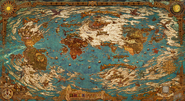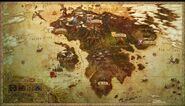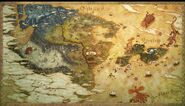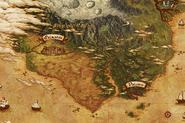Hydaelyn—a vibrant planet blessed by the light of the Crystal. Amid azure seas, encompassing the westernmost of the Three Great Continents there lies a realm embraced by gods and forged by heroes. Her name...Eorzea.
Final Fantasy XIV Opening Movie
The Source, also known as Hydaelyn (ハイデリン, Haiderin?), is the primary setting of Final Fantasy XIV. While the planet's current commonly known name is derived from the name of deity-like figure who guides the player character, with "the Source" being used more often in the discussion of multiplanetary and metaphysical concepts, the planet's name prior to Hydaelyn's influence was Etheirys (アーテリス, Āterisu?).
This world is the original star from which Hydaelyn's thirteen reflections were sundered.[1] One of these reflections, the First, is the main setting of Final Fantasy XIV: Shadowbringers.
Maps[]
The world of Hydaelyn is made up of several landmasses, the largest of which are Aldenard, Ilsabard, Othard, Meracydia, and Tural, known as the "New World" to Eorzeans. Only the realms of Eorzea, the Old World, and the Far East have been completely revealed through the use of maps.[2]
The planet has had two artificial satellites: the red moon Dalamud, and silver moon Menphina, often referred to simply as "the moon".
Races[]
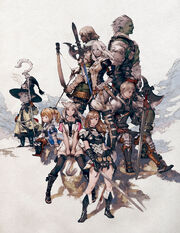
Members of the Five Races most commonly seen in Eorzea.
The many peoples of the Source are divided between the "five wandering races" (i.e. Hyur, Elezen, Roegadyn, Lalafell, and Miqo'te) and the beastmen, or beast tribes. This contrived distinction is largely a result of recent societal divisions. Many of the sapient races of the modern era are descended from the Ancients who were sundered in the battle between Hydaelyn and Zodiark.
Playable races[]
The Hyur are the most widespread of Hydaelyn's races, forming a significant population in almost every corner of the planet, with some even inhabiting the New World and Meracydia. They are characterized by their average height and build and rounded ears. They are known for their love of personal freedom, wide variety of traditions, and their adaptability.
Hyur native to Eorzea are roughly divided into two clans: the Midlander clan that inhabits the realm's low-lying regions and the Highlander clan that calls the realm's mountains home.
Tall and slender, the Elezen are characterized by their long, pointed ears. They are known to live not only in Eorzea, but Ilsabard, the isles of Sharlayan, and the kingdom of Dalmasca, with some seen to be native to Meracydia in the distant past. They tend to hold fast to their traditions, taking great pride in their history, and live about one- or two-tenths longer than Hyur on average.
While the Elezen native to the Black Shroud are divided between the Wildwood and Duskwight clans, the Elezen of Ishgard and Sharlayan are considered their own, distinct clans.
The large and brawny Roegadyn are the most rugged of the wandering races. Native to the Old World island of Aerslaent, their seafaring people have spread across Aldenard, Ilsabard, and Othard. While many of them have a reputation for piracy, history speaks of the courageous deeds of Roegadyn warriors in equal regard. They are also known for their explorers, as it was Roegadyn who founded the nations of Sharlayan and Limsa Lominsa, and discovered the New World.
The Sea Wolf clan still make their home on Aerslaent, but many of them came to Eorzea and founded Limsa Lominsa centuries ago. The Hellsguard clan live in the mountains of Abalathia's Spine, but their mercenary tradition leads them to leave home in pursuit of work in places like Ala Mhigo and Ul'dah.
Small of stature and youthful in appearance, the Lalafells are known for their welcoming nature and mercantile trade. Native to the south sea isles, they migrated to Eorzea and have become one of the best established races in the realm, particularly in Ul'dah and Limsa Lominsa. Outside of the realm, they can still be found in their native lands, the northern isles of Sharlayan, and the island of Thavnair.
The Plainsfolk clan of Lalafells largely dwell in La Noscea, and are the primary inhabitants of their native isles, while the Dunesfolk clan came about after years of wandering the deserts of southern Aldenard and make up a majority population in Ul'dah.
Though they generally prefer to remain apart from civilization in nomadic tribes, the proud and territorial Miqo'te have achieved great success as adventurers. They're known for their feline ears and tails and their females far outnumbering their males, a unique trait among Eorzea's races.
The diurnal Seekers of the Sun are a patriarchal society divided into twenty-six tribes with known populations in La Noscea, Gyr Abania, and Thanalan. Their nocturnal counterparts, the matriarchal Keepers of the Moon, are seldom seen outside of the Black Shroud, where they live in numerous, family-sized tribes.
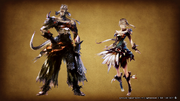
The Au Ra are native to the Far East.
A race rarely seen in Eorzea until recently, the Au Ra hail from the Azim Steppe in the far eastern continent of Othard. Said to have been created by the Dawn Father Azim, god of the sun, and Dusk Mother Nhaama, goddess of the moon, their creation myths claim that they waged war on one another for their deities until they put aside their differences, inspiring the gods to leave the world to their children.
The white-scaled Auri Raen clan left their native soil many years ago, spreading across the lands of the Far East and integrating into the nations of Doma and Hingashi. The black-scaled Auri Xaela still call the steppe home, where their many clans still live nomadic lives full of conflict.

The Viera are a seldom-seen race in any part of Hydaelyn.
An extremely rare race characterized by their large, leporine ears, the Viera make their home in southern Othard. Known for their extremely territorial nature, female Viera live in small villages with their children. Adult males lead solitary lives, almost never seen, even by their female counterparts. On rare occasion, female Viera will leave the forest to live in the outside world.
The Viera possess an incredible longevity compared to other races, with some living upward of two centuries.
The Rava Viera live in the Golmore Jungle in Dalmasca, fiercely guarding their forest home from all intrusion. Their sister clan, the Veena, live similar lives in the wintry forests of the Skatay Range northwest of Dalmasca.
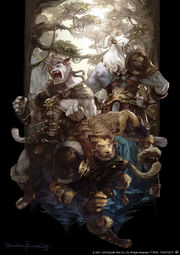
The Hrothgar are native to Ilsabard.
A leonine, bestial-looking race, the Hrothgar have lived in Ilsabard for millennia. During the Third Astral Era, members of this race, led by their queen Gunnhildr, distinguished themselves by defying the Allagan Empire with their unique discipline: the Gunbreaker.
In modern times, descendants of Gunnhildr's Blades formed a large population in Bozja Citadel under the Garlean Empire until its destruction fifteen years ago.
The Hrothgar's fearsome appearance initially caused conflict when they came to Eorzea, but they are currently accepted in all corners of the realm. Females among their kind are rare, and traditional Hrothgar clans are matriarchal, led by one of several queens.
There are two designations of Hrothgar, but these are less clans and more a matter of circumstance. Helion is the term for a Hrothgar in service to a queen, their surnames bearing her name with an "A-" prefix, meaning "in service to", while the Lost are those Hrothgar who have lost their queen, removing the "A-" and replacing it with a "-sch" suffix, meaning "lost".
Other races[]
- Garlean
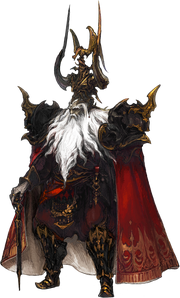
Pureblooded Garleans have a third eye on their forehead.
Though their heritage traces back to the Ivalician city of Goug, their ancestors were ultimately forced to the coldest northern reaches of Ilsabard due to their inability to wield magic. There, they founded the small nation of Garlemald. Roughly fifty years ago, the Garlean Empire was founded by Solus zos Galvus, whose magitek armies placed the whole of Ilsabard and Othard under Garlean control.
Pureblooded Garleans are distinguished by the chitinous third eye at the center of their forehead, which can vary in size, shape, and color. The third eye grants them enhanced spatial perception, which helps them aim using ranged weaponry and makes them suited to piloting airships. Garlean headgear is typically built to not obstruct the third eye.
Garlean purebloods vary widely in size, ranging from roughly the height of Midlander Hyur to the height of Elezen, or even taller. They appear to age at the same rate as most other races, as Emperor Solus was confined to his deathbed by age eighty-eight.
Padjal are born among certain Hyuran families of Gridania, a race of horned seers who can understand the voices of the elementals. They remain youthful in appearance for their whole lives, only showing their age as their hair turns white, but living upwards of two centuries. Because of their gifts, they are largely bound to the Black Shroud, where they often serve as mediators between man and elemental.
The Ascians are an enigmatic race of immortals characterized by the masks they wear over their faces and their black cloaks. Their name comes from their appearances in legends, where they are said to lack shadows. Called Paragons by the beast tribes, whom they manipulate by teaching the art of summoning primals, these malevolent bringers of chaos seek to cause calamities on Hydaelyn.
It is revealed in Shadowbringers that Ascians are in fact the remnant of a progenitor civilization built on the unsundered world of Etheirys, its people simply called Ancients. In their original form, the Ancients looked like Hyur with the elongated limbs of the Elezen. They had vast aether, even capable of using creation magicks.
Beastmen[]
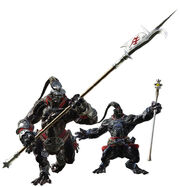
The Amalj'aa tribe.
In Eorzea, "beastman" is a derogatory term used to separate certain races from the so-called "five races" of the realm. Garleans, Au Ra, and even Padjal, may not be considered part of the "five" despite those deemed beastmen possessing intelligence and customs as rich and diverse as any of the races of 'man'.
After the Garlean Empire began its campaign of conquest across the Three Great Continents, they deemed that any who would summon their gods as primals, or "eikons" as the Empire called them, were not to be tolerated. Those who associated with beastmen or spoke their tongue (such as those who gained that ability through the Echo) the Empire considered equal to beastmen.
Shortly after Ala Mhigo fell to the Garlean Empire, the sultanate of Ul'dah officially coined the term "beast tribe" to refer to those "foreign" entities whose interest directly opposed the city-state, ejecting them in the interest of lowering the risk of Garlean aggression. This artificial division sowed distrust towards the victimized peoples, the Syndicate profiting off the confusion.[3]
Peoples labeled "beast tribes" include, but are not limited to, the following:
- Amalj'aa: lizard-like people native to Thanalan desert
- Ixal: flightless bird-like people native to Abalathia's Spine
- Kobold: mole-like people residing to the north of La Noscea
- Sahagin: fish-like people residing in the shores and undersea the island of Vylbrand
- Sylph: plant-like people residing in the Black Shroud
- Moogle: furry creatures residing in Twelveswood
- Vanu Vanu: bird-like people residing in the Sea of Clouds
- Gnath: insect-like people residing in the Dravanian Forelands
- Ananta: snakelike people residing in Gyr Abania
In the lands of the Far East, southern Ilsabard, and Tural, no such division exists. The turtle-like Kojin, catfish-like Namazu, wolf-like Lupin, humanoid winged-people Tengu, elephant-like Matanga, the lizard-like Mamool Ja, and the diminutive Pelupelu are considered the same as any other person, and the term "beast tribe" is never used by the people of those lands to describe their neighbors. The Seeq, Bangaa, and Moogles of southern Othard are likewise treated as ordinary citizens.
Dragons[]

Dragons originally came from another star.
Dragons are an extraterrestrial race originally hailing from the Dragonstar. Millennia ago, the Father of Dragons, Midgardsormr escaped the conflict of the Dragonstar, came to the world of Hydaelyn bearing seven eggs. He entered into a pact with the Mothercrystal to dwell upon the world, his seven children becoming the great wyrms of the first brood who spread out and created broods of their own across the world.
Geography[]
Hydaelyn is made up of five main continents: Aldenard, Ilsabard, Othard, Meracydia, and Tural. The first three are connected by land and collectively known as the Three Great Continents. Meracydia is separated from the main continents by the southern seas, while Tural, the "New World", lies far to the west across Indigo Deep.
Regional folklore claims that Aldenard, Ilsabard, and Othard were once inseparable brothers. Ilsabard and Othard grew jealous of Aldenard for, despite being the youngest, he possessed the richest lands. In a fit of anger, the brothers pulled themselves away from Aldenard to where they now stand, Aldenard's outstretched hand clinging to Ilsabard's coattail trying to bring him back.
Several continents and other outlying islands are further grouped or broken up into geographical regions including Eorzea, the Near East, the Far East, the Old World, and the Southern Islands.
Eorzea[]
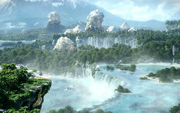
Eorzea, a land embraced by gods and forged by heroes.
The realm of Eorzea is the main setting of Final Fantasy XIV and comprises the continent of Aldenard and its surrounding islands.
Northern Aldenard[]
Much of northern Aldenard is dominated by a vast mountain range known as Abalathia's Spine, which stretches from Dravania in the west to Gyr Abania in the east, fully encompassing the highlands of Coerthas, canyons of Xelphatol, and the volcanic Farreach.
Gyr Abania is a barren and harsh land, home to the martial city-state of Ala Mhigo. Coerthas is home to the Holy See of Ishgard, a formerly alpine climate that has fallen victim to constant ice and snow since the Seventh Umbral Calamity. Ten years ago, a colony of Sharlayan also existed in Dravania, but the scholars abandoned their city-state in response to the threat of Garlean aggression.
Over the mountains of Abalathia's Spine is a series of countless floating islands known as the Sea of Clouds, which includes the Diadem and the lost Allagan research facility of Azys Lla.
Southern Aldenard[]
At the heart of Aldenard lies Lake Silvertear in Mor Dhona, to the west of which is the Yafaem Saltmoor. Mor Dhona was lush and fertile until the Battle of Silvertear Skies was waged ten years ago. It has since become a crystalline wasteland characterized by noxious fumes and dangerous monsters. Three-thousand years ago, Yafaem was home to the black magic civilization of Mhach.
Aldenard's southeastern regions are made up of the massive forest known as the Black Shroud, controlled by Gridania, and the Amalj'aa homeland of Paglth'an. The Black Shroud, or Twelveswood to its inhabitants, is full of various flora and fauna and controlled by the elementals who provide it vitality. Beneath the Shroud is a complex network of now-abandoned cave systems that once made up the city-state of Gelmorra.
Much of southern Aldenard is taken up by an expanse of deserts, the most notable of which is Thanalan, home to the sultanate of Ul'dah. Though it lacks in agricultural resources, the presence of the so-called "jewel of the desert" provides the land with wealth beyond that of the other Eorzean regions. The region is home to a sizable amount of mineral deposits and a wealth of ceruleum. The Sagolii Desert and the Grand Wake are other examples of deserts in the region.
West of Thanalan lies the Carteneau Flats, ground zero of the Seventh Umbral Calamity, now used by the Grand Companies as a staging ground for elaborate but non-fatal war-games.
Surrounding Islands[]
Vylbrand is the largest island in Eorzea, located off its western coast across the Strait of Merlthor. The southern half of Vylbrand, La Noscea, is the domain of Limsa Lominsa. The island's northern half around the volcanic O'Ghomoro is the domain of the Kobolds.
Other islands within the realm include the Cieldalaes, a tropical archipelago south of Vylbrand, and both Mazlaya and the Pearl in the waters of the Rothlyt Sound off Aldenard's eastern coast.
Ilsabard and the Near East[]
Ilsabard is the largest of the Three Great Continents. Southern Ilsabard and its surrounding islands make up the region known as the Near East. The most notable locations in the region are Garlemald, capital of the Garlean Empire that controls the whole of the mainland, and Radz-at-Han on the island of Thavnair off the southern coast, the city-state credited with giving birth to modern alchemy.
Other civilizations on mainland Ilsabard include Bozja, located near its border with Othard and once home to Bozja Citadel, and the nation of Corvos, home to famed swordsmen. Nearby islands include Cape Mete, and various islands in the treacherous waters of the Drown and the Sirensong Sea.
The Far East[]
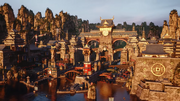
Kugane is considered the gateway to the Far East.
The Far East encompasses Othard and its surrounding islands and is first visited in Final Fantasy XIV: Stormblood. It is home to the nations of Doma and Hingashi, as well as the former kingdom of Dalmasca to the south. The mainland is divided between the civilizations in its southern and northern halves.
Northern Othard[]
Northern Othard is home to a massive river known as the One River, which wends its way from the Tail Mountains in the north, though the vast Azim Steppe, and through the lands of Yanxia, separating the lands of Doma from the Fanged Crescent. Because of the One River, Yanxia historically enjoyed lush and fertile lands, and its mountains have a unique, pillar-like shape threaded through its fields.
The Azim Steppe is the ancestral homeland of the Au Ra race. Though the Raen left these lands long ago, the Xaela tribes still call it home. A large, flat expanse of grassland, the steppe is known for its chill winds, savage beasts, and impressive warriors. To its west is the Nhaama Desert, a bleak and inhospitable land nonetheless inhabited by Xaela tribes who have adapted to the harsh environment. Northeast of the Steppe, are the coastal Arras region and the Ryakgyr Peninsula, while to the northwest are the peaks of the Tail Mountains and tundras of the Dalvalan Grath.
At the center of Othard is a permanently barren wasteland known as the Burn. Though Solus zos Galvus famously claimed the state of this region was due to a succession of primal summonings, which inspired his declaration that the Empire will subjugate any who summon such "eikons", it was actually caused when the Allagan Empire deliberately starved the region of aether in order to raise a portion of it into the sky to create Azys Lla. The Skatay Range forms a southern border with the Burn. The forested foothills far side of the mountain range's western terminus are home to the Veena clan of Viera.
Southern Othard[]
Southwest of Yanxia is Nagxia, a sparsely-populated region characterized by the heat and humidity of its subtropical climate and its near-constant rain. Its dense jungles and swampy ground make for poor farmland, and it has yet to produce a historically significant nation. It fell to the Empire three years after Dalmasca as a stepping stone to the northern half of Othard.
Southern Othard was once largely the domain of Dalmasca with its capital at Rabanastre in the heart of the vast Dalmasca Desert. It controlled the large port city of Valnain to the southwest in the lush lands east of Greylic's Bend. At the center of the region is the vast Golmore Jungle, home to the territorial Rava clan of Viera.
Thirty years ago, Dalmasca fell to the Garlean Empire, separating the deserts and Rabanstre into Dalmasca Superior while the Golmore Jungle and Valnain became known as Dalmasca Inferior.
Surrounding Islands[]
The most notable islands near Othard are the archipelago that makes up the nation of Hingashi. Based primarily on the large island of Koshu, the Hingan capital of Bukyo is located southwest of the massive mountain Daitenzan. Though this main island is off-limits to almost all foreigners, or "ijin", the smaller island of Shishu has opened a solitary port to foreign trade, the city of Kugane. The bugyo has also opened a resedential district for ijin on the island of Shirogane.
The body of water between Othard and Hingashi is the Ruby Sea, sometimes called the Ruby Tide. Historically, it is the domain of pirates known as the Confederacy who are all but recognized as an official power in the Far East. Making their headquarters on Onokoro, they tax any ships seeking passage through their waters, but the Garlean Empire's technological superiority has seen their influence wane in recent years. Onokoro is also home to Heaven-on-High, a mysterious tower that stretches far into the skies above.
Beneath the waters of the Rasen Kaikyo is the village of Tamamizu, home to the Kojin of the Blue, a peaceful society who have used their magicks to weave an impressive bubble around their underwater home, as they lack the ability to breathe underwater without aid.
When a small group of Raen arrived in the Ruby Sea long ago, seeking to flee the wars on the surface, the Kojin showed them how to perform these magicks as well. Their underwater village of Sui-no-Sato is a refuge to its people, barring re-entry to those who choose to leave, and seeking to remain apart from the troubles of the surface. They are ruled by the Ruby Princess Kurenai Shisui, whose palace in Shisui of the Violet Tides is located in the depths of the Turquoise Trench far southwest of the village.
Hells' Lid is a notable island near Othard that has a large active volcano. Though it is thought to be the home of dangerous and powerful oni, it is—in fact—home to the Four Lords, powerful auspices who protect the seal on a dangerous auspice named Koryu from within Reisen Temple below.
South Sea Islands[]
The seas south of Eorzea are dotted with countless, tiny islands, and are characterized by a warm, pleasant climate. These islands are the ancestral homeland of the Lalafells, whose catamaran-like ships allowed them to cross ocean to the Great Continents. Interaction between these isles and Eorzea is abundant, most of it going through Limsa Lominsa's ports. The magic art of arcanima originated on these islands.
Meracydia[]

Meracydia as seen from the moon.
Located far to the south of the Three Great Continents, Meracydia was home to the dragons of the Meracydian Horde over five millennia ago. When the Allagan Empire sought to conquer the continent, the dawn wyrm Bahamut fought and died to defend his homeland. The ensuing war ravaged Meracydia, a succession of primal summonings depleting the land's aether.
While some areas still remain uninhabitable, those which have been repopulated remain recluse and shun contact with the civilizations of the northern hemisphere, often attacking any who approach by sea or air, with the only known avenue of trade being with Thavnair. Little of the region is known, including geographical information, but it is known that migrating Miqo'te tribes brought sesame seeds from the southern continent.
The Northern Empty[]
The Northern Empty is a sea to the north of Aldenard and west of Ilsabard. The islands that dot the Northern Empty comprise the what is known colloquially as the "Old World". Most prominent among these are the five islands of Sharlayan, sometimes called "Old Sharlayan" to distinguish it from the now-defunct colony its scholars founded in Dravania. Apart from the main island of Sharlayan, they also control the northern Isle of Haam, the southern Isle of Yorn, and the eastern Isle of Val.
The Roegadyn homeland of Aerslaent (meaning "first land") is also located in the frigid northern seas, as is the island of Nagyn (meaning "origin") which, according to old Roegadyn legends, is the place from which all of the world originated.
Tural[]
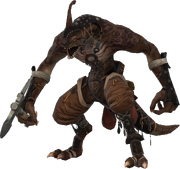
The Mamool Ja are the dominant people of Tural.
Tural was rediscovered by the rest of the world in 1500 of the Sixth Astral Era by the explorer Ketenramm the Blue, who wished to name it "Ketenland". This name did not catch on and it is instead known colloquially to the Three Great Continents as "The New World". Ketenramm met with the natives, visiting the nation of Mamook and ingratiating himself with the Mamool Ja autarch. According to Emet-Selch the New World has cities of gold.
The Whalaqee tribe of Hyur also call the continent home, a tribe of Hyur said to be able to see into the souls of beasts and control their aether. Their traditions, as well as their blue clothing based on the ceruleum deposits in their native land, inspired the art of blue magic recently brought to Eorzea.
Major nations[]
Limsa Lominsa[]
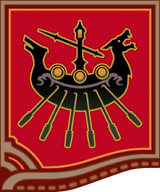
Flag of the thalassocracy of Limsa Lominsa.
Founded in 875 of the Sixth Astral Era, the maritime city-state was founded by Sea Wolf refugees from Aerslaent. Forced to leave their homeland after a failed rebellion against a tyrannical king, Admiral Elilwaen and the crew of his flagship Galadion, came to Vylbrand believing it was uninhabited. After conflict erupted with the native Kobolds, they were forced to build in the reefs around their derelict vessel. At first, Limsa was a shanty town, the Lominsan populace made up of coinless refugees. This changed after occupying the nearby forests, allowing them to build ships and use their skills as sailors to engage in piracy across the Five Seas.
This lasted for several centuries, but the decline of piracy's golden age and threat of the Garlean Empire caused the current Admiral, Merlwyb Bloefhiswyn, to outlaw piracy altogether in the interest of forging lasting alliances with the other city-states of Eorzea. She created the Lominsan Grand Company, the Maelstrom, in 1572 of the Sixth Astral Era, consolidating all the city-state's resources to defeating the Garlean Empire.
Though the original founders of Limsa Lominsa were Sea Wolf Roegadyn, Miqo'te Seekers of the Sun and Midlander Hyur came to dwell in the city-state after being forced to serve aboard pirate ships, while Plainsfolk Lalafells came to trade in stolen goods. The native Kobolds still make their home in the north of Vylbrand, and the Sahagin have claimed a place in western La Noscea.
The flag of the thalassocracy depicts a pirate ship, representing the nation's founders: brutal Sea Wolf buccaneers. The crimson field represents the spilled blood of lost companions and reflects the city-state's bloody history.
Ul'dah[]
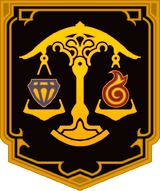
Flag of the sultanate of Ul'dah.
The sultanate has its roots in the nation of Belah'dia that held Thanalan until a war of succession tore it apart in 969 of the Sixth Astral Era. The twin rulers founded their own nations, Ul'dah and Sil'dih, which engaged in a bloody conflict known as the War of the Sisters. Sil'dih was destroyed in 1181 when an alchemical powder transformed its armies into the undead. Ul'dah has held dominion over Thanalan ever since.
Shortly after the war, the reigning Sasagan Ul Sisigan III was ousted in favor of Baldurf Thorne, ending the reign of the first Ul Dynasty and beginning the lost Thorne Dynasty of Ul'dahn sultans. After the Thornes abdicated in 1355, the second Ul Dynasty came to power. True power in Ul'dah soon fell to the merchant class, which had grown powerful. In an attempt to keep the merchants loyal to the throne, the sultanate created the Syndicate, but it soon came to hold more power in the city-state than the throne.
The untimely demise of sultan Sasabal Ul Sisibal and his wife Nanasha Ul Nasha in 1561 caused their daughter, Nanamo Ul Namo, to ascend the throne at the age of five. The Syndicate officiated over all for a long time until she won the loyalty of the Ala Mhigan gladiator Raubahn Aldynn, who used his winnings in the coliseum to buy his freedom and a seat on the Syndicate. He created the Ul'dahn Grand Company, the Immortal Flames, to both combat Garlemald and place power in the hands of the royal house.
While Dunesfolk Lalafell make up the majority of Ul'dah's citizens by a small margin, the city-state also contains a sizeable population of Midlander Hyur with small but notable populations of Hellsguard Roegadyn and Highlander Hyur. The populations of refugees from Ala Mhigo and the Calamity may have shifted these demographics somewhat. Despite the Immortal Flames' efforts, the Amalj'aa have entrenched themselves in southern Thanalan.
The black flag of Ul'dah depicts a set of golden scales holding the jewel of prosperity on the left and the flame of might on the right. The symbols originate from Belah'dia, where the scale instead weighed the flame of power and the grapes of knowledge.
Gridania[]
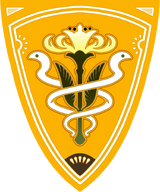
Flag of the city-state of Gridania.
Gridania's history begins with Gelmorra, the subterranean city-state founded by Hyur and Elezen around the year 740 of the Sixth Astral Era. In 1076, a Hyuran mage named Jorin Lightheart created the art of conjury to commune with the elementals of the forests above. Successful in gaining their permission to dwell within the forest, he led the people of Gelmorra from their caverns to found the city-state of Gridania.
The people of Gridania lead largely peaceful lives, but the Ixal who inhabited the forest before the elementals evicted them seek to reclaim the forest as their own. In 1468, they also had to defend their territories from Ala Mhigo in a conflict known as the Autumn War. The Ala Mhigans were swiftly routed when Ishgard, Limsa Lominsa, and Ul'dah lent their aid to Gridania, driving them from the forest by 1469.
The current leader of Gridania, Kan-E-Senna created the Order of the Twin Adder in 1572 to deal with the Garlean threat. After the Calamity, the elementals were severely weakened, making the Black Shroud a less threatening place to outsiders, but leaving the city-state vulnerable to incursions.
Like Gelmorra before it, the majority of Gridanians are Elezen and Midlander Hyur. A rift formed between the Elezen when they were asked to leave Gelmorra. Those who chose to dwell in the forest became the Wildwood clan, and those who tried to remain in their underground home became the Duskwight clan, with no love lost between the two. The Black Shroud is also home to Miqo'te Keepers of the Moon, who often face discrimination like the Duskwights. The Sylph tribe also makes their home in East Shroud.
The golden field of the Gridanian standard represents the land filled with the elementals' power. The entwined serpents originate with Gelmorra, representing the unity between Elezen and Hyur.
Ishgard[]
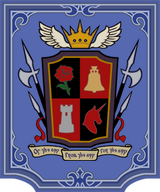
Flag of the Holy See of Ishgard.
According to the Enchiridion, the book of holy scripture of the Ishgardian Orthodox Church, the Holy See of Ishgard was founded when King Thordan led the Elezen to the promised land of Coerthas. The dragon Nidhogg attacked them, killing the king, but his son, Haldrath, took the wyrm's eye and forced him to retreat. In the wake of the king's demise, Haldrath refused the crown and became the first Azure Dragoon. The Elezen chose to put power in faith, annointing an archbishop as sovereign of their new nation with the remaining knights founding the four High Houses of Ishgard.
Nidhogg and his Dravanian Horde waged a thousand-year war against the Ishgardians, attacking them fiercely between long periods of rest. Though the Holy See was part of the original Eorzean Alliance, it withdrew its support in 1562 of the Sixth Astral Era to focus on the Dragonsong War, isolating the main city from almost all outsiders.
When the Calamity struck ten years later, Coerthas became trapped in an eternal winter that continues even in the Seventh Astral Era five years later. Recent events caused Ishgard to undergo a dramatic change in leadership, forming a bicameral republic with a House of Lords and House of Commons and rejoining the Eorzean Alliance.
Unlike most of Eorzea's city-states, which feature diverse races, the people of Ishgard are almost entirely made up of Ishgardian Elezen with a minority of Midlander Hyur and a very small number of any other race. The Ixal have also taken up residence in Natalan in the central highlands, a forward camp to attack Gridania from the north.
Ishgard's banner displays the crests of the four High Houses on an escutcheon and the winged crown on top represents the archbishop. The city-state's motto, "Of the Sky, From the Sky, For the Sky", is featured beneath the sigils.
Ala Mhigo[]
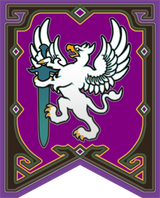
Flag of the nation of Ala Mhigo.
For centuries, the Highlander clans of Gyr Abania warred among one another for what little resources their lands could provide. That changed in 1100 of the Sixth Astral Era, when Anshelm Cotter united the clans under his leadership and founded the city-state of Ala Mhigo.
The city-state prospered for centuries through mercenaries, salt and other minerals, taxation on overland routes to the Near East, and trade with regions beyond Eorzea. The increase in sea trade saw the toll routes abandoned by most merchants and, in 1468, King Manfred decided to wage a war of conquest on Gridania to gain its fertile land. They were defeated within a year, the other city-states of the realm—save for Sharlayan—uniting to end Ala Mhigo's conquest.
In the years that followed, the royal house's power gave way to the monkhood of the Fist of Rhalgr. In 1552, King Theodoric purged the monks and, in his paranoia, began purging anyone he perceived as a threat to his rule. The XIVth Imperial Legion of Garlemald attacked their border and, on the day rebels ended Theodoric's tyranny, they swiftly found themselves under the heel of the Garlean Empire.
The lives of Ala Mhigans in their homeland became harsh and brutal as a result of Garlean occupation while their refugees flooded the streets of Ul'dah, living hand to mouth. A successful rebellion backed by the Eorzean Alliance liberated Ala Mhigo from Garlemald, and it is currently ruled by an elected council of representatives from all corners of Gyr Abania.
While most of Ala Mhigo's populace are Highlander Hyur, Gyr Abania is also home to smaller populations of Seeker of the Sun Miqo'te, Hellsguard Roegadyn, and Midlander Hyur. The Ananta and some Qiqirn also call the rugged highlands home.
The Ala Mhigan flag displays a silver griffin, with a sword in its talons, the symbol of its royal house. The purple color represents Rhalgr and the element of lightning and marks the bond between the royal house and the Fist of Rhalgr. The Ala Mhigan Resistance also has its own, violet banner with a streaking comet at its center.
The Garlean Empire[]
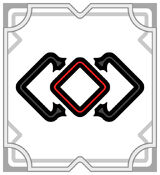
Flag of the Garlean Empire.
Founded in 922 of the Sixth Astral Era as the Republic of Garlemald, the people struggled to survive in their icy homeland for centuries until the rise of Solus Galvus, who joined the Republican army in 1505 and by 1517 was named Dictator. By 1522, all of Ilsabard was unified under Garlean rule, utilizing magitek and airships, allowing Solus to name himself the first emperor of the Garlean Empire.
Garlemald set its sights on Othard, toppling Dalmasca in 1547, Nagxia in 1550, and Doma in 1552. The XIVth Imperial Legion achieved victory on Aldenard through subterfuge, taking Ala Mhigo in 1557 by using the political unrest already tearing the nation apart to its advantage.
Most infamous of Garlemald's actions was Meteor Project, responsible for bringing about the Seventh Umbral Calamity. In 1572, the VIIth Imperial Legion legatus Nael van Darnus brought down the lesser moon Dalamud onto Eorzea, seeking to wipe out its peoples and clear the way for Garlean conquest. Despite the mad legatus's death, the moon fell and broke open, revealing the elder primal Bahamut, who unleashed his fury upon the realm.
At the height of its power, the Empire ruled two of the Three Great Continents along with Gyr Abania in Eorzea. However, recent rebellions have freed the lands of Ala Mhigo and Doma from imperial rule in the wake of Emperor Solus's death and the rise of Varis zos Galvus.
Citizens of the imperial capital enjoy lives uplifted by technology, which helps compensate for the Garlean purebloods' near-complete inability to use magic. While official censuses from Garlemald list pureblood Garleans as the most populous race, this is because they do not count "aan" (members of conquered nations who have not earned Garlean citizenship) in their population figures.
The imperial standard is an abstract depiction of a chain, representing unity. The red link symbolizes the blood of those who have died in the name of the Garlean people.
Doma[]
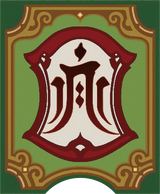
Flag of the Kingdom of Doma.
A young nation compared to its ancient counterpart across the sea, the nation was founded by Ganen Rijin, who united the lands of Yanxia roughly seven-hundred and seventy-seven years ago by forging alliances not only between Hyur, Roegadyn, and Au Ra, but also between the Namazu and Lupin of his homeland, as well as through his talent for geomancy.
Though the Rijin clan remained firmly in control of Doma, three-hundred years ago, a conflict arose between the decadant Seien Rijin and his responsible younger brother Shoen Rijin. With the aid of Sasuke Kagekakushi, a Hingan shinobi, he raised a rebel army and deposed his tyrannical brother. Sasuke remained to found Shinobi-no-Sato, passing the discipline down to generations of Domans.
In 1552 of the Sixth Astral Era, during the reign of Kaien Rijin, Doma fell to the Garlean Empire. Lord Kaien was allowed to maintain his throne, but became little more than a figurehead for a Garlean viceroy.
After the dawn of the Seventh Astral Era, following the death of Emperor Solus, Lord Kaien led his people into open rebellion against Garlemald. They were swiftly crushed by crown prince Zenos yae Galvus, who slew Kaien and placed the nation under the XIIth Imperial Legion's rule until the nation was freed roughly a year later and Hien Rijin was restored to the throne.
Much like Hingashi, the people of Doma are largely Far Eastern Hyur with notable minority populations of Far Eastern Roegadyn and Auri Raen. Lupin and Namazu also make up a small population in Doma.
The flag of Doma uses the character for the nation's name, the red border surrounding it represents the royal family's role as gatekeepers of the One River. The green color represents the rice plants that grow in Doma's many fields.
Hingashi[]
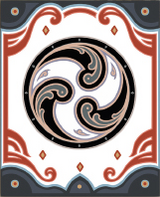
Flag of the bakufu government of Hingashi.
Hingashi is an ancient nation founded on an archipelago east of Othard proper. Made up of Koshu, Shishu, and a few other islands, 2,500 years ago a clan united western Koshu under one banner, giving rise to a millennium-long line of Hingan emperors. 1,500 years ago, a war of succession broke out between an emperor in the east and empress in the west.
This conflict began the Age of Blood, a period of war that gave birth to the samurai and ninja disciplines. After six-hundred years of conflict, Kanzan Mitsurugi, leader of the Mitsurugi Clan of Onokuni, used strategy to forge alliances and outdo his rivals to gain dominion over Hingashi.
Kanzan restored the imperial household to power, declaring his own mandate to rule as shogun came from the Hingan emperor, but the Mitsurugi Bakufu that he created came to hold true power over the nation even in the modern day.
Hingashi is known to be an oddity as not much is known about the nation 2,500 years prior, and its isolation makes any research difficult. What is known is that not many Allagan artifacts are found on this land.
In the wake of the Garlean Empire's expansion, Hingashi declared itself neutral. While maintaining strict isolationist policies, it has opened a single port city, Kugane, to foreign trade.
The majority of Hingan citizens are Far Eastern Hyur, but they also have notable populations of Far Eastern Roegadyn and Auri Raen. Many of the Raen also hold positions of power in Hingashi, such as Ichian Matsuba, the Kugane bugyo, or Yuki Yatsurugi, princess of Inokuni.
The flag typically seen to represent Hingashi displays the symbol of the ruling Mitsurugi Clan, a black circle with three waves curving inward. This symbol is not a national standard.
Dalmasca[]
The Kingdom of Dalmasca spanned a thousand-year-long history prior to its invasion by Garlemald. Ruled by the B'nargin line, Dalmasca occupied a geopolitcally vital location as a gateway to Othard from Ilsabard. Though it was the target of numerous invasions over its history, the position of its capital, Rabanastre near the Skatay Range protected it for years.
In 1547, the Garlean Empire launched its new fleet of improved airships to invade Dalmasca. The final battle took place at Nalbina Fortress, where IVth Legion legatus, Basch van Gabranth, slew Prince Rasler, Princess Ashelia, and seventy-thousand souls along with them. The king conceded the crown and passed away shortly after.
In the years since, the new Diocese of Dalmasca was divided between "Dalmasca Superior" comprising the Dalmasca Desert and Rabanstre, and "Dalmasca Inferior" containing the Golmore Jungle and Greylic's Bend, with Lea Monde and Valnain within it.
Its people never truly stopped fighting imperial oppression and the three decades of imperial rule were marked by ceaseless uprisings. This culminated in the Barheim Incident, in which IVth Legion legatus Noah van Gabranth called upon the XIVth Imperial Legion legatus, Gaius van Baelsar, for aid. XIVth Legion tribunus, Livia sas Junius, earned the moniker "Witch of Dalmasca" for her part in hunting down suspected rebels and slaughtering them without trial.
Shortly after the liberation of Ala Mhigo and Doma, the nation attempted yet another failed uprising. Intent on making an example to other imperial provinces, the empire razed Rabanastre with its gunships, leaving much of the Desert Sapphire in ruins.
The main populace of Dalmasca were Dalmascan Hyur, but they also had a notable population of Bangaa with minority populations of Seeq and Viera. Roughly a quarter of Dalmasca's population were from other races, likely due to the large span of the fallen kingdom.
The banners of Dalmasca depicted the B'nargin coat of arms, known as the "Suncrest" by locals. The Garleans forbade Dalmascans from flying the banner during their occupation.
Sharlayan[]
Founded by descendants of Eorzeans saved from the Sixth Umbral Calamity by Nyunkrepf Nyunkrepfsyn, the northern islands of Sharlayan are known as a shining seat of knowledge. In 1361 of the Sixth Umbral Era, the Sharlayans created a colony in Dravania that became a city-state in its own right. After Ala Mhigo's fall they voted to abandon the colony and, in 1562, returned to the northern seas.
The notable Archon Louisoix Leveilleur, fearing the Seventh Umbral Calamity was nigh, chose to defy his nation's policy of non-interference. He founded the Circle of Knowing with twelve of his students and colleagues, and ultimately gave his life to help stop the Calamity from destroying the realm. His Circle of Knowing joined with the Path of the Twelve to form the Scions of the Seventh Dawn, and continue to help the people of Eorzea.
The banner of Sharlayan depicts a nautilus, a symbol of the deity Thaliak. As men have long believed mollusks lived forever, the spiral shell has represented wisdom and knowledge since time immemorial.
Tuliyollal[]
Located in southern part of Tural, the nation of Tuliyollal was founded around eighty years ago by the Dawnservant Gulool Ja Ja to unite the various different peoples of Tural to bring an end to the constant fighting between them. The nation's capital's name is the same as the nation. Since the founding of the nation, Tuliyollal has been living in undisturbed peace.
The nation serves as a home to multitude of different races, but it is mainly governed by the Mamool Ja.
Minor nations[]
Aerslaent[]
The Sea Wolves still maintain a dominant presence on the islands of Aerslaent long after the departure of the Galadion.
Bozja[]
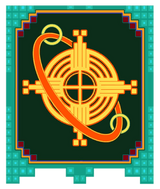
Flag of the nation of Bozja.
A nation in southern Ilsabard conquered by the Garlean Empire during the reign of Emperor Solus, Bozja is best known for the Bozja Incident. In 1562 of the Sixth Astral Era, tests on a lunar transmitter meant to bring Dalamud down onto Eorzea went awry. A flare of explosive aether struck the city of Bozja Citadel, wiping it out in an instant. The most notable casualty of the incident was Midas nan Garlond, the lead researcher of the Meteor Project and father of Cid Garlond.
Corvos[]
A nation on the southern coast of Ilsabard, Corvos is the nation that gives the Corvos Narrow its name. They produce swordsmen of surpassing skill, one of whom served as a tutor to imperial prince Zenos yae Galvus in his youth.
It is known to the Garleans as Locus Amoenus, and was their ancestral home before they were driven to the frigid wastes of the north.
The right foot of an ancient monument, the Anchorite at Corvos, stands on the shore. It's said that the left foot of the colossal statue once stood on the Thavnair side, but the statue has long since been lost.
Idyllshire[]
The free nation of Idyllshire was founded in the abandoned colony of Sharlayan in the hinterlands of Dravania fairly recently. Treasure hunters led by Midnight Dew and goblins led by Slowfix Cointoss came together to construct a libertarian bastion of those who value freedom above all else. The city is built into a small portion of what once made up the scholars' colony, its sole entrance at the Cenotaph.
Landis[]
A nation in Ilsabard that was taken over by Garlemald, Landis was home to Basch van Gabranth, who rose to the rank of legatus despite not being a native Garlean. His son and successor, Noah van Gabranth, also hails from Landis.
Mamook[]
Located on the New World, Mamook is the homeland of the Mamool Ja. Led by their autarch, the explorer Ketenramm the Blue visited this nation in 1499 of the Sixth Astral Era and returned with treasures of the finest silver.
Nhalmasque[]
A small nation located in the mountains of central Ilsabard, Nhalmasque fell to the Garlean Empire in 1517 of the Sixth Astral Era, notable as the first imperial conquest to make use of airships.
Radz-at-Han[]
On the island of Thavnair in the waters of the Bounty is the ancient city-state of Radz-at-Han, birthplace of modern alchemy. While lacking an outward military presence, the city-state has a non-interference policy with the Garlean Empire, and remains an independent nation while serving as a hub for trade between Eorzea, Garlemald, and Hingashi.
Radz-at-Han is populated by Hyur, Auri and Arkasodara tribe of Matanga and led by a satrap.
Werlyt[]
A small nation that fell victim to an epidemic approximately ten years ago. Gaius van Baelsar adopted several orphans from the region who later went on to become pilots for the Empire's Weapons project.
Citations[]
- ↑ The Word of the Mother: "Across ten and three were we then divided. Reflections of the Source, each possessed of a shard."
- ↑ Encyclopædia Eorzea: The World of Final Fantasy XIV pg. 012-013
- ↑ Encyclopædia Eorzea: The World of Final Fantasy XIV Volume II, p. 250

